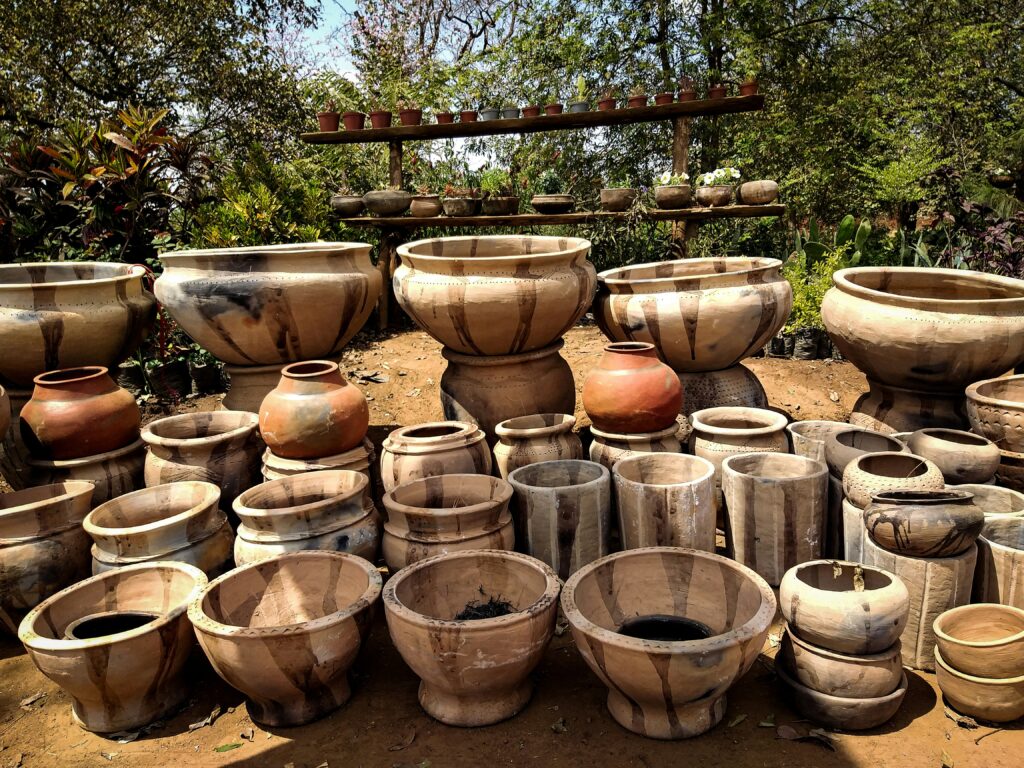Nothing is more satisfying than using fresh herbs from your Herb garden containers to enhance meals, but what if you don’t have much room? Do not be alarmed! A versatile and enjoyable way to produce herbs inside or on patios, balconies, or windowsills is via container gardening. These container ideas for herb gardens will encourage you to start planting, regardless of your gardening experience—no backyard is necessary!
Why Opt for Herb Gardens in Containers?

Beginners and those with limited space will love container gardening. It allows you to relocate plants as required, minimises insect problems, and gives you control over water, sunshine, and soil quality. Additionally, containers enhance the visual appeal of any environment! Let’s get started with some innovative but doable strategies to get you producing herbs.
Herb Gardens That Hang.

Use repurposed buckets, coconut coir baskets, or macramé hangers to hang plants. Trailing plants like ivy, oregano, or creeping thyme look gorgeous in hanging arrangements. Put them beneath a patio canopy or near a window with plenty of sunlight. Selecting Herbs for Storage
Choose appropriate herbs for your area and lighting levels, since not all herbs grow well in pots.
Sun Lovers: oregano, basil, rosemary, and thyme (6+ hours of sunshine). Mint, cilantro, parsley, and chives provide some shade. Bay leaf, chervil, and lemon balm are indoor-friendly (near light windows).
Basics of Planting for Novices Soil: Use a potting mix that drains well; add sand or perlite for further drainage. When watering, make sure the soil is damp but not waterlogged.
Check with a finger inserted one inch deep. Feeding: Use organic liquid fertiliser every four to six weeks. Fun Themes That Are Creative Pizza Garden: Fill a big container with parsley, oregano, and basil. Grow lemon verbena, chamomile, and mint for a tea lover’s mix. Bright Combinations: For a striking effect, combine purple basil, variegated sage, and golden thyme.
Solving Typical Problems Leggy Plants: Switch pots often or relocate to a sunnier area. Yellow Leaves: Is it too much water? In between waterings, let the soil dry out. Pests: Apply diluted neem oil or manually remove insects.
Last Words of Advice for Achievement: Start with three to four herbs to prevent overload. Use painted pebbles or popsicle sticks to identify containers. Harvest often to promote bushy growth! With these herb garden container ideas, you can turn even the smallest space into a fragrant, verdant haven. Have fun with your gardening!
Traditional Pots with a Modern Touch

Begin with something basic: classic options include Terracotta containers, plastic planters, and ceramic pots. Make sure they have drainage holes to avoid root rot.
Paint simple pots with vibrant hues or designs for a fun touch; arrange pots of varying sizes on a balcony railing or windowsill to create visual interest.
Pro Tip: Use lightweight plastic pots for hanging arrangements to minimize hard lifting.
Repurposed Treasures
Make unusual planters out of everyday objects! Colanders, teacups, mason jars, and old tin cans can transform into quaint herb houses. Make drainage holes at the bottom or place stones on the dirt. An adorable kitchen windowsill garden may be created by painting a row of mason jars and labelling them with chalk paint.
Idea: Make a vertical platform for tiered pot displays from an old wooden ladder.
Tight Spaces with Vertical Gardens

Use shoe organizers, hanging baskets, or wall-mounted plants to maximize your vertical space. Herbs such as parsley, thyme, and oregano thrive in fabric pocket organizers (similar to those used for shoes); add soil and place them on a bright wall. Another rustic alternative is pallet planters, where you may line the slats with landscaping fabric to create planting niches or hold tiny pots.
Window boxes and planters with tiers

Planters with tiers save space and provide depth. Seek stackable pots or use crates to make a tiered stand yourself. Plant various herbs, such as mint, cilantro, and basil, in window boxes for convenient cooking access. They’re not just for flowers.
Furniture Repurposed
Rejuvenate outdated furniture! Turn a wheelbarrow, cabinet, or wooden drawer into an herb garden. Fill drawers with soil after lining them with burlap or plastic (punch drainage holes). An antique toolbox is a useful planter and décor on a patio table.
Fabric pots and grow bags
Fabric grow bags are perfect for herbs since they are portable and reasonably priced. They encourage air circulation to avoid overwatering, so they are ideal for herbs with deep roots like dill or rosemary. Bonus: They fold flat for storage!
